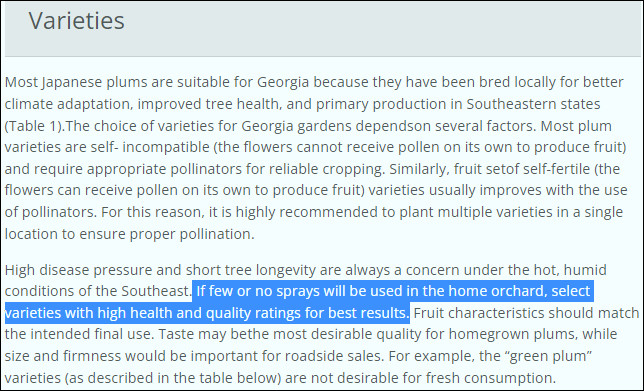Now that I have decided to give up on Peaches (removed all 3 trees a few weeks ago)… my mind is drifting back to Plums again. Got rid of peaches because of pest (OFM) and disease (BR) issues… eventually just got to be too overwhelming – and I “do not spray” which makes those pretty much impossible to overcome.
So now back to THINKING more about Plums.
In my first post above I explained my experience with Plums… (J and EU types)… and my EU Plums are now in year 6 and still no blooms, no fruit. I will not plant a EU plum again ever… don’t like waiting that long for something to produce… I will leave these two for someone else to eat (I expect).
The demise of my J Plums was our rather frequent late frosts and the fact that the two J Plums I had started blooming Mid Feb. They must have been extra early bloomers (varieties unknown at this point).
In the thread above, Shiro was mentioned as often producing some fruit even with late frosts… and @mamuang mentioned Satsuma was known to be a good pollinator.
But @IL847 - said Shiro was the first plum to bloom in her orchard… which makes me think our late frosts will not be good for it.
This takes me back to considering the Alderman plum (american-japanese hybrid)…
Superior and Tonka (also american-japanese hybrids) are mentioned above as a possible good pollination pair. Most nurseries recommend those for pollination…
One Green World says…
Shiro - blooms in March
Tonka - blooms in March
Superior - blooms in late March
Gurnies says that Shiro is 2-Early, Superior and Alderman are 3-Mid (on Bloom time).
And reading post here on Alderman I found this one… from @nil who is in Zone 8b
If Alderman does bloom for me here in 7a, just a week or two later than Superior and Toka… that might make a significant difference in my late frost issue.
@jaypeedee - had some good comments on Alderman in (zone 8b also) above… (very good plum) - top tier keeper.
Sounds like it can deal with the heat and humidity… which I have plenty of that too.
I would like to ask jaypeedee and nil… (or anyone else that knows)… if you know which of your other J-plum varieties or A/J hybrids, bloom at the same time as your Alderman plum trees ?
Many nurseries list Alderman and Superior as pollinators… but per Nil above Alderman bloomed later than her Superior in z8b.
I found these comments by a staff member of Starks online…
Which list some other J/A hybrids… Waneta, Pipestone, Underwood… are any of those known to bloom later than Superior (perhaps with Alderman) ?
Edit - add later… just found this pollination chart for (J and J/A hybrids) at BurntRidge…

They do not have Alderman in their list… but do have Superior and Toka listed as Mid bloomers…
and Beauty and Elephant Heart J-Plums as Late Bloomers.
If Alderman blooms significantly later than Superior (in Zone 8b)… perhaps Alderman & Beauty would be a good pollination pair ?
Ok… still researching and found this a bit later…

That is from Summit Tree Sales (Michigan)… much more North than me… and they are saying Alderman pollinates with Superior and Blackice (Hybrids).
They did not have Beauty J-plum in their list.
Thanks
TNHunter







